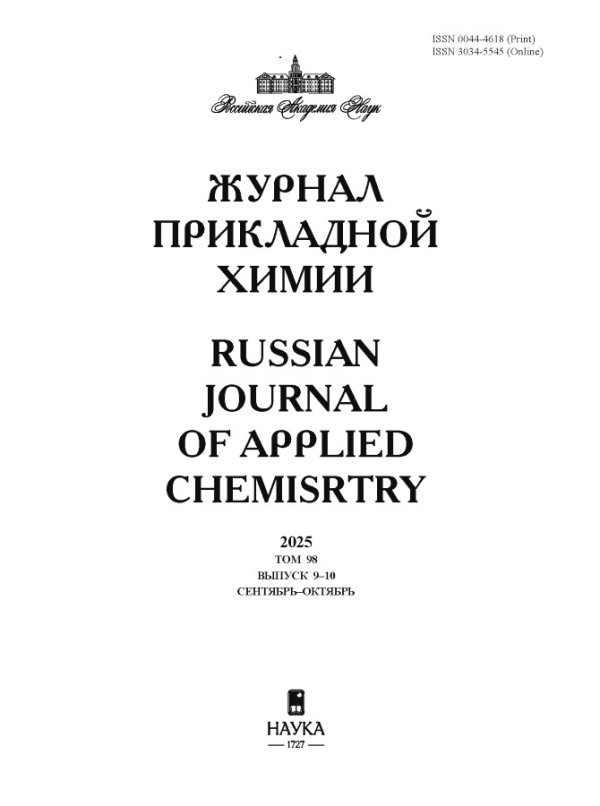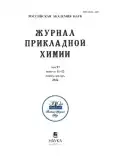Применение модели последовательных сопротивлений для описания процесса ультрафильтрационной очистки отработанного моторного масла
- Authors: Маркелов А.В.1,2, Осадчий Ю.П.3
-
Affiliations:
- Ярославский государственный технический университет (ЯГТУ)
- Институт нефтехимического синтеза им. А. В. Топчиева РАН
- Ивановский государственный политехнический университет
- Issue: Vol 97, No 11-12 (2024)
- Pages: 795-802
- Section: Special technological processes
- URL: https://modernonco.orscience.ru/0044-4618/article/view/681628
- DOI: https://doi.org/10.31857/S0044461824110070
- EDN: https://elibrary.ru/PTNOLY
- ID: 681628
Cite item
Abstract
Исследован процесс регенерации отработанных моторных масел с использованием ультрафильтрационных полимерных мембран на основе фторопласта. Показано, что на сопротивление массопереносу через мембрану в процессе ультрафильтрации отработанных моторных масел оказывает значительное влияние концентрирование в примембранном слое задерживаемых продуктов деструкции масла. В результате проведенных экспериментов была определена зависимость сопротивления концентрационной поляризации от времени. Полученная эмпирическая зависимость использовалась для численно-аналитического решения задачи по определению удельной производительности мембран и концентрации продуктов окисления масла в питающем резервуаре. Верификация модели путем сравнения экспериментальных и расчетных значений концентрации примесей показала погрешность не более 5%, а удельной производительности — в пределах 10–15%. Данный подход можно использовать для определения периодичности профилактических воздействий по восстановлению проницаемости мембран в инженерных расчетах подобных баромембранных аппаратов.
Full Text
About the authors
А. В. Маркелов
Ярославский государственный технический университет (ЯГТУ); Институт нефтехимического синтеза им. А. В. Топчиева РАН
Author for correspondence.
Email: aleksandr203.37@mail.ru
ORCID iD: 0000-0001-7125-6570
д.т.н.
Russian Federation, 150023, г. Ярославль, Московский пр., д. 88; 119991, ГСП-1, г. Москва, Ленинский пр., д. 29Ю. П. Осадчий
Ивановский государственный политехнический университет
Email: aleksandr203.37@mail.ru
ORCID iD: 0000-0003-2279-0990
д.т.н.
Russian Federation, 153000, г. Иваново, Шереметевский пр., д. 21References
- Выборнова Т. С., Власова Г. В., Пименов Ю. Т. Очистка минеральных и синтетических моторных масел от механических примесей посредством физических воздействий // Сетевое издание «Нефтегазовое дело». 2023. № 2. С. 172–184. https://dx.doi.org/10.17122/ogbus-2023-2-172-184
- Jurny M., Elbourawi M., Zorgani E. Recycling of used engine oil using extraction by single solvent // Am. J. Chem. Eng. 2023. V. 11. N 2. P. 33–38. https://doi.org/10.11648/j.ajche.20231102.11
- Pinheiro C. T., Quina M. J., Gando-Ferreira L. M. Management of waste lubricant oil in Europe: A circular economy approach // Crit. Rev. Environ. Sci. Technol. 2021. V. 51. P. 2015–2050. https://doi.org/10.1080/10643389.2020.1771887
- Остриков В. В., Афоничев Д. Н., Оробинский В. И., Балабанов В. И. Удаление продуктов старения из работающих моторных масел без их слива из картеров двигателей машин // Химия и технология топлив и масел. 2020. № 3 (619). С. 18–21. https://www.elibrary.ru/kklsjd [Ostrikov V. V., Afonichev D. N., Orobinskii V. I., Balabanov V. I. Removal of aging products from
- working motor oils without draining them from engine crankcases // Chemistry and Technology of Fuels and Oils. 2020. V. 56. N 3. P. 347–351. https://doi.org/10.1007/s10553-020-01162-2].
- Sholl D. S., Lively R. P. Seven chemical separations to change the world // Nature. 2016. V. 532. N 7600. P. 435–437. 10.1038/532435a' target='_blank'>https://doi.org/doi: 10.1038/532435a
- Картошкин А. П. Концепция сбора и переработки отработанных смазочных масел // Химия и технология топлив и масел. 2003. № 4 (518). С. 3–5. https://elibrary.ru/phgvxr?ysclid=m5u00243pb769144386 [Kartoshkin A. P. The notion of collection and treatment of spent lube oils // Chemistry and Technology of Fuels and Oils. 2003. V. 39. N 4. P. 155–158. https://doi.org/10.1023/A:1025436609440].
- Mandloi H., Thakur L. S. A Review on recycle of waste lubricant oil and its properties enhancement // Int. J. Res. Appl. Sci. Eng. Technol. 2023. N 11. P. 4368–4371. https://doi.org/10.22214/ijraset.2023.54461
- Nissar A., Hanief M., Mir F. Q. Critical retrospection and evaluation of waste engine oil recycling methods // Int. J. Energy Water Resour. 2023. N 7. P. 453–464. https://doi.org/10.1007/s42108-023-00240-5
- Nebesskaya A., Kanateva A., Borisov R., Yushkin A., Volkov V., Volkov A. Polyacrylonitrile ultrafiltration membrane for separation of used engine oil // Polymers. 2024. V. 16. N 20. ID 2910. https://doi.org/10.3390/polym16202910
- Sarkar S., Datta D., Deepak K. S., Mondal B. K., Das B. Comprehensive investigation of various re-refining technologies of used lubricating oil: A review // J. Mater. Cycles Waste Manag. 2023. N 25. P. 1935–1965. https://doi.org/10.1007/s10163-023-01685-w
- Markelov A. V., Sokolov A. V. Regeneration of ultrafiltration membranes in the process of separating oil-water systems // ChemChemTech. 2023. V. 66. N 1. P. 114–119. https://doi.org/10.6060/ivkkt.20236601.6718
- Markelov A. V., Nebesskaya A. P., Shvorobey Yu. V., Yushkin A. A., Volkov A. V., Volkov V. V. Regeneration of used engine oil with ultra filtration membranes // Processes of Petrochemistry and oil Refining. 2024. N 4. P. 1064–1071. https://doi.org/10.62972/1726-4685.2024.4.1064
- Федосов С. В., Маркелов А. В., Соколов А. В., Осадчий Ю. П. Коагуляция и ультрафильтрация: гибридный процесс очистки отработанных моторных масел // Мембраны и мембран. технологии. 2022. Т. 12. № 5. С. 341–350. https://doi.org/10.31857/S2218117222050054 [Fedosov S. V., Markelov A. V., Sokolov A. V., Osadchy Yu. P. Coagulation and ultrafiltration: A hybrid process for purification of used engine oils // Membranes and Membrane Technologies. 2022. V. 4. N 5. P. 297–305. https://doi.org/10.1134/S2517751622050055].
- Wang L., Cao T., Dykstra J. E., Porada S., Biesheuvel P. M., Elimelech M. Salt and water transport in reverse osmosis membranes: Beyond the solution-diffusion model // Environ. Sci. Technol. 2021. V. 55. N 24. P. 16665–16675. https://doi.org/10.1021/acs.est.1c05649
- Ho C.-C. A combined pore blockage and cake filtration model for protein fouling during microfiltration // J. Colloid Interface Sci. 2000. V. 232. N 2. P. 389–399. https://doi.org/10.1006/jcis.2000.7231
- Жужиков В. А. Теория и практика фильтрования суспензий. М.: Химия, 1971. С. 24–41.
- Waite T. D., Schäfer A. I., Fane A. G., Heuer A. Colloidal fouling of ultrafiltration membranes: Impact of aggregate structure and size // J. Colloid Interface Sci. 1999. V. 212 (2). Р. 264–274. https://doi.org/10.1006/jcis.1998.6040
- Costa A. R., de Pinho M. N., Elimelech M. Mechanism of colloidal natural organic matter in ultrafiltration // J. Membr. Sci. 2006. V. 281. P. 716–725. https://doi.org/10.1016/j.memsci.2006.04.044
- Дытнерский Ю. И. Баромембранные процессы. Теория и расчет. М.: Химия, 1986. С. 59–61.
Supplementary files














